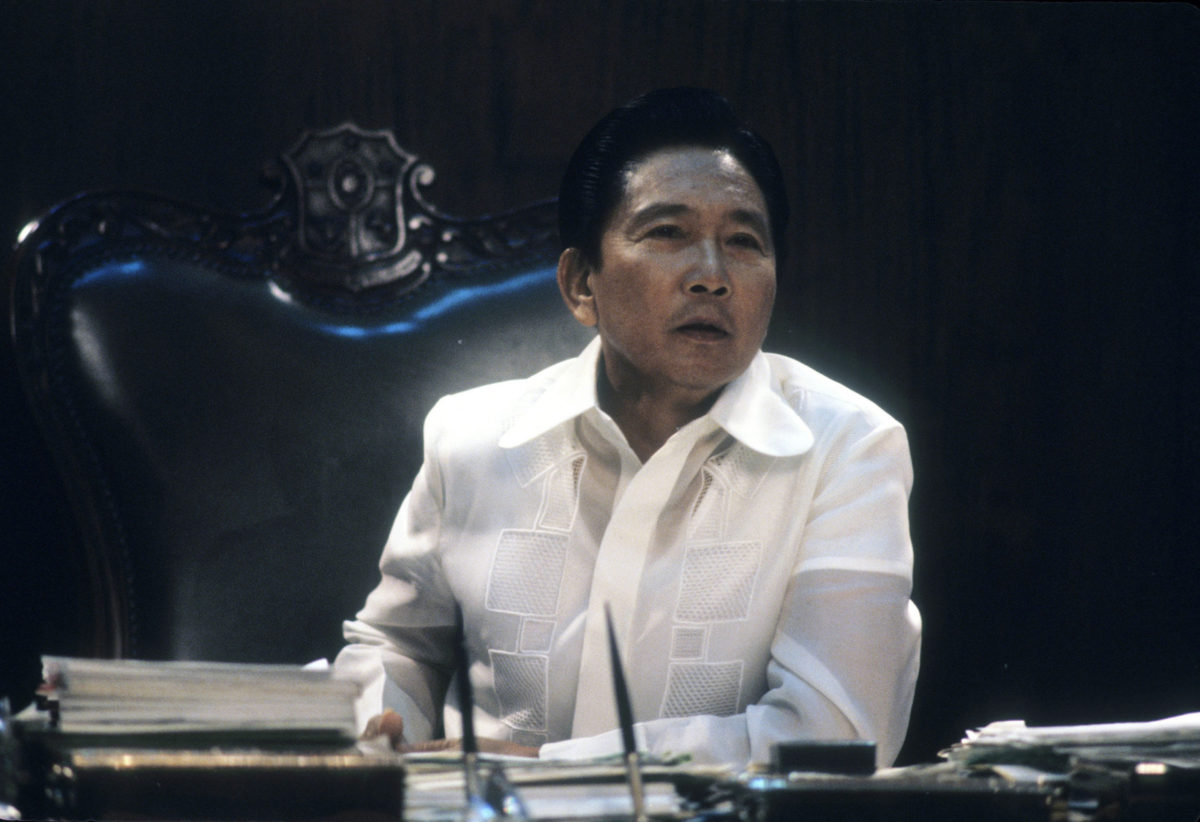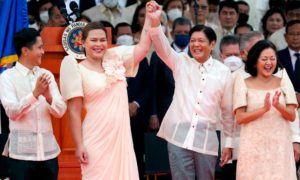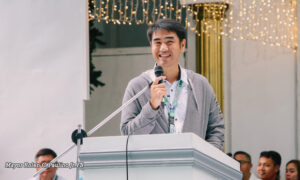Ferdinand Emmanuel Edralin Marcos was born on September 11, 1917, in the town of Sarrat, Ilocos Norte, to Mariano Marcos (1897–1945) and Josefa Edralin (1893–1988). Mariano Marcos was a lawyer and congressman from Ilocos Norte, Philippines. Josefa Marcos was a schoolteacher who would far outlive her husband—dying in 1988. Ferdinand Marcos Sr served as the 10th President of the Philippines.
Marcos studied law at the University of the Philippines in Manila, attending the College of Law. He excelled in both curricular and extra-curricular activities, becoming a member of the university’s swimming, boxing, and wrestling teams. He was also an accomplished orator, debater, and writer for the student newspaper.
Early political career
After the end of the war and the establishment of the Republic, President Manuel A. Roxas appointed Marcos as special technical assistant. Later, Marcos ran as Representative (of the 2nd district of Ilocos Norte) under the Liberal Party – the administration party. During the campaign he told his constituents “Elect me a Congressman now and I pledge you an Ilocano President in 20 years.” He was elected thrice as Congressman. In 1959 he was catapulted to the Senate with the highest number of votes. He immediately became its Minority Floor Leader. In 1963, after a tumultuous rigodon in the Senate, he was elected its President despite being in the minority party.
President Diosdado Macapagal, who had promised not to run for reelection and to support Marcos’ candidacy for the presidency in the 1965 elections, reneged on his promise. Marcos then resigned from the Liberal Party. With the support of his wife Imelda Romualdez Marcos, he joined the Nacionalista Party and became its standard-bearer with Senator Fernando Lopez as his running mate.
Presidency
Marcos defeated Macapagal and was sworn in as the sixth President of the Republic on December 30, 1965.
In his first State of the Nation Address (SONA), President Marcos revealed his plans for economic development and good government. President Marcos wanted the immediate construction of roads, bridges and public works which includes 16,000 kilometers of feeder roads, some 30,000 lineal meters of permanent bridges, a generator with an electric power capacity of on million kilowatts (1,000,000 kW), water services to eight regions and 38 localities.
He also urged the revitalization of the Judiciary, the national defense posture and the fight against smuggling, criminality, and graft and corruption in the government.
To accomplish his goals “President Marcos mobilized the manpower and resources of the Armed Forces of the Philippines (AFP) for action to complement civilian agencies in such activities as infrastructure construction; economic planning and program execution; regional and industrial site planning and development; community development and others.” The President, likewise, hired technocrats and highly educated persons to form part of the Cabinet and staff.
October 24, 1966: President Marcos presiding over a meeting of the Manila Conference of SEATO nations on the Vietnam War.
It was during his first term that the North Diversion Road (now, North Luzon Expressway) (initially from Balintawak to Tabang, Guiguinto, Bulacan) was constructed with the help of the AFP engineering construction battalion.
Aside from infrastructure development, the following were some of the notable achievements of the first four years of the Marcos administration:
1. Successful drive against smuggling. In 1966, more than 100 important smugglers were arrested; in three years 1966-1968 the arrests totaled 5,000. Military men involved in smuggling were forced to retire.
2. Greater production of rice by promoting the cultivation of IR-8 hybrid rice. In 1968 the Philippines became self-sufficient in rice, the first time in history since the American period. In addition, the Philippines exported rice worth US$7 million.
3. Land reform was given an impetus during the first term of President Marcos. 3,739 hectares of lands in Central Luzon were distributed to the farmers.
4. In the field of foreign relations, the Philippines hosted the summit of seven heads of state (the United States, South [Vietnam], South Korea, Thailand, Australia, New Zealand and the Philippines) to discuss the worsening problem in Vietnam and the containment of communism in the region.
Likewise, President Marcos initiated, together with the other four heads of state of Southeast Asia (Indonesia, Malaysia, Thailand and Singapore), the formation of a regional organization to combat the communist threat in the region – the Association of Southeast Asian Nations (ASEAN).
5. Government finances were stabilized by higher revenue collections and loans from treasury bonds, foreign lending institutions and foreign governments.
6. Peace and order substantially improved in most provinces however situations in Manila and some provinces continued to deteriorate until the imposition of martial law in 1972.
FROM QUORA: Do you agree that Ferdinand Marcos is the best president in the Philippines?
User Astraea Answered: Yes, definitely.
The following are the list of common perceptions between the Marcos regime, which unfortunately, twisted in its own way:
- “Ferdinand Marcos’ Martial Law brought to the collapse of the Philippines.”
Martial Law was imposed for the fact that there was civil unrest and communist threat at that time. Legislators and lawmakers agreed, and Marcos even ordered the organization of Citizen Assemblies, wherein citizens would be asked whether they liked or approve the reforms done under Martial Law, Congress and the Constitution. Regarding the civil unrest, there were wars around different parts of the world, World War II also for that matter. The communist threat at that time, the New People’s Army (NPA) with its co-founder Ninoy Aquino (from the official MNLF website), sowed panic in the Philippines with usual bombing events and the plan to overthrow the regime. But during Martial Law, the main leaders of Communist parties were brought to jail and the foundation of Communism weakened due to the strict regulations under Martial Law. And let me clarify, most of those crimes during Martial Law were NOT done by the military. Human rights violation? It was done by communists then they blamed it to the soldiers. THEY TOOK THE UNIFORMS of soldiers they killed then abuse the citizens so that they will think it was the doings of the military. This was strengthened through the use of media.
2. “The Marcoses are thieves.”
This accusation was tested in the Manila Regional Trial Court and the International Court in America. More than 900 cases filed by the government against Marcos and NONE of those cases were proven to be true. Why was it not televised? How did the Marcoses defend their ground? Who was the real thief and the victim? The government even lay claim to the properties of the Marcos family by force in return for unfreezing the bank account of the Marcoses. They say Marcos stole billions and billions of dollars from the country’s coffers, but we don’t have that large amount of money at that time. And media does its thing, manipulation. And oh, did I say that the Marcos family already had gold bars even before Ferdinand’s presidency?
3. “Ferdinand Marcos is bad because our elementary history books tell us so.”
First of all, Cory Aquino replaced all textbooks regarding the rule of Marcos. Bookstores banned from selling copies, the book “Greed and Betrayal” erased and the works of journalists who witnessed the reign of Marcos. The misdoings of Aquinos and Cojuangcos also hidden for what? Obviously, to cover up their dirt and be called as the “heroes that freed us from our demise”. The oligarch ruled our countries and manipulated everything we hear and see. During the reign of Marcos, televisions were forbidden because misinformation was evident, and so the Aquinos used the newspapers instead to persuade the citizens. We are robbed of our right to know the truth, of the history of Marcos regime, of the access to information regarding the Philippines. Our elementary books are no more than another platform to engrave our minds of the thought that the heroes are the Aquinos and the villain, Marcos. How after 3 decades and still most citizens think like this, is baffling.
4. “Marcos only know of bloodshed, this is what makes him a tyrant.”
Before you fully stake that claim, let me ask, have you compared the buildings, legislations and reforms under the rule of Marcos from the previous presidents? Marcos built 20 nuclear powerplants (other powerplants not included), built 8 well-known bridges and hundreds of unnamed bridges with San Juanico bridge as the longest (2060 meters long), constructed hundreds of universities and highschools, as well as a list of agrarian reforms, education reforms, food sufficiency, health care, housings, energy sources, labor reforms, export, massive infrastructure growth, political reforms, fiscal reforms and peace and order. 60% of his works are still being used today. His contribution to the Philippines was unprecedented and no feats of the previous presidents can equate to that of his. Ramos and Cory’s national budget even amounted to trillions while Marcos only had 400+ million. If we compare it to the rule of Cory Aquino, NO POWERPLANTS, NO UNIVERSITIES AND HIGHSCHOOLS were founded. Instead, we have been wiped out from the ranks of developing countries and still continue to plummet down for the last decades. Ferdinand Marcos said, “This nation shall be great again.” but what happened to the nation now? Broke and fueled by corruption.
5. “Ferdinand Marcos is a dictator.”
All the actions he imposed are constitutional and mandated by law. In his rule, public schools don’t require tuitions, food programs were held on a weekly basis, the fish, tilapia was firstly introduced, globally recognized innovations, Philippines was the leading importer of rice etc. tell us that he cared for the welfare of our country. But again, the media became an effective tool to corrode the minds of citizens, even a show (by Dr. Leloy Claudio) claimed that Ferdinand Marcos founded NPA and that he used the bombings as a means to fool citizens, this is not proven. In fact, Ninoy Aquino teamed with the NPA to make it seem like it was the fault of the government. Who knows, maybe Ninoy’s death was by the hands of his own comrades. Though,it is apparent that we lack information of how exactly Ferdinand Marcos be considered a dictator.
After Marcos lost his presidency:
Statement from Marcos to Cory, Hawaii 1987:
“Ang kabilin-bilinan ko kay Mrs. Corazon Aquino na ipatuloy ang Bataan Nuclear Plant kung maaari. Sapagka’t, this is the solution in meeting the country’s energy demands and decreasing dependence on imported oil. Ngunit ayaw niyang tanggapin ang aking mungkahe dahil maaalala daw ng taong bayan si Marcos habang nandyaan ang Nuclear Power Plant. Anong klaseng pag-iisip yan? Iyan ay paghihiganti, huwag natin idamay ang sambayanang Pilipino. Balang araw makikita ninyo, 20 years from now, bagsak na ang Pilipinas.”
In this statement, it meant Marcos’s message to Cory to continue the Bataan Nuclear Plant, but Cory refused as it will remind the Filipinos of Marcos. To which Ferdinand Marcos questioned her and stated that the Philippines will fall after 20 years.
Isn’t that ironic? It happened so quickly that now, the Philippines has become a mere speck in the global setting.
Juan Ponce Enrile, an ally of Cory, February 19, 2022:
“Paano naging dictatorship si Presidente Marcos? He was operating under the 1935 Constitution all the time under Martial Law. How can he be considered dictatorship? Everything he did was authorized and mandated by Filipino People.”
Juan questions how Ferdinand Marcos be considered as a dictator. He said that everything Marcos has done was under the 1935 Constitution under Martal Law and authorized, mandated by the Filipinos.
Where was the promise of the 1986 EDSA to make our country better? Instead the innovations were sold including the 67% government-owned properties.
Are we really sure that what we believe and stand for is true? There is more to how Marcos operates the country than meets the eye. The previous statements tells us how media, corruption and the oligarchs played a powerful role in the end of Marcos’ reign.
Maybe soon, the Philippines will be great again, in the hands of another knowledgeable leader, which happens to be the Son of the Greatest Philippine President, the newly elected President, Ferdinand “Bongbong” Marcos Jr.






















